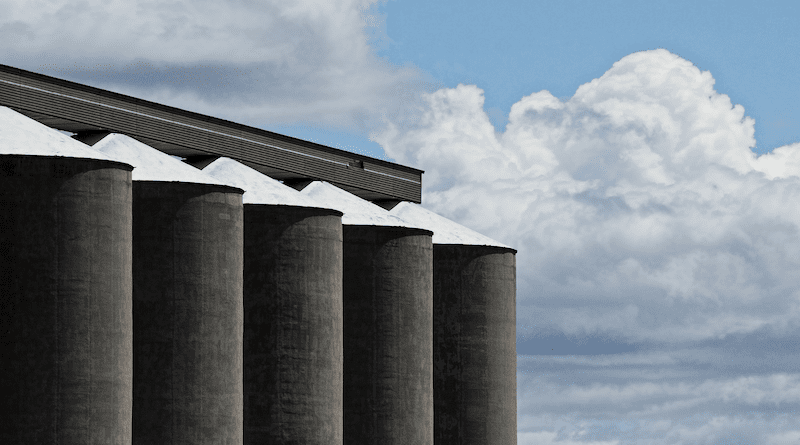Electronic Warehouse Receipt Financing: Still In A Nascent Stage – OpEd
The Government of Pakistan (GoP) came up with an alternative delivery system for the benefit of farmers in year 2013. It is aimed at achieving financial inclusion of farmers, improve their financial conditions and on top of all achieving food security. The irony was that when the program was launched there was no supporting infrastructure in the country. The work had to be started from ground zero, with all the stakeholders joining their hands and the GoP taking the lead.
If one looks at more than one decade of history, the progress is not very encouraging. On top of all hardly a few modern grains storage facilities have been constructed. Some basic questions arise, if there are no accredited storage facilities, how can the electronic warehouse receipts (ESRs) be issued? If farmers have no EWRs how can they borrow from the financial institutions?
A further probe indicates that a collateral management company has been established, it has accredited around a dozen flat-bed warehouses. However, hardly any warehouse with silos has been accredited. In the last financial year EWRs worth one billion rupees were issued and lending worth PKR700 million was made. The numbers look dismal keeping in view the size of just three crops, namely wheat, maize and rice.
Whatever EWRs have been issued were for maize and paddy, but not a single EWR has been issued for wheat. The point worth noting is that the country produces around 25 million tons wheat every year. The real cause of concern is that in the absence of modern grain storage silos, around 20% quantity goes stale before reaching the market. This is huge loss for the farmers as well as for the country.
As stated earlier, the GoP as well as the financial institutions have failed in convincing the potential investors to establish grain storage silo facilities. The point worth mentioning is that for the current financial year (FY23) State Bank of Pakistan (SBP) has fixed an indicative target of lending to farmers at PKR1.8 trillion. Against this target lending of PKR700 million against EWRs looks disappointing.
The introduction of EWRs in Pakistan is aimed at offering three options to the farmers: 1) safekeeping of commodities to avoid distress selling and post-harvest losses, 2) using EWR as collateral for borrowing from financial institutions and 3) trading of EWRs at the PMEX platform to efficiently sell the produce at a fair price.
The recent media reports indicate that at present only two commercial banks, out of more than two dozen, are running awareness sessions about lending against EWRs. These may be the banks that have lent significant amounts against EWRs. A question comes to minds what the other financial institutions are doing? It is necessary to reiterate that if there are no warehouses, no EWRs will be issued: If no EWRs are issued how the financial institutions would lend against the EWRs.
The EWR mechanism aims at improving the performance of the agricultural sector by stimulating economic growth both in the agricultural sector and also in the construction sector by creating an incentive for the private sector in constructing new warehouses. This will increase the capacity of the country to store agricultural produce without wastage, alleviating poverty and reducing shortages of agricultural produce in Pakistan.
The readers may be keen in knowing why a reasonably high amount has been lent against maize? According to the sector analysts chicken feed manufacturers has been the biggest beneficiary. They have the silos, warehouse management system, a large number of farmers/ suppliers and above all history of borrowing from the financial institutions. The lenders were comfortable in extending credit to financially strong borrowers.
Analysts are of the view that unless an ecosystem is introduced for the storage of wheat, the efforts will not yield the significant results. However, the problem is that there are no silos. Historically the government has been the major buyer of wheat, but just does not have finances to buy more than more than 10 million tons. Almost the entire bought quantity is stored in highly inefficient flat-bed warehouses or kept in open.
A common complaint is that farmers are not ready to sell their produce to the government. However, the growers have contrary narrative. They say the government does not offer good price, there are extra ordinary delays in releasing payment and at time farmers get jittery because of fast approaching monsoon. The unscrupulous elements take advantage of the situation and force the farmers to sell their produce below the price fixed by the government.
Another narrative is that agents of neighboring country not only do expeditious buying but also pay a price which is higher than the support price fixed by the government. Soon after the purchase wheat is transferred to the ‘hideouts’. That is the reason that the government has to import wheat to meet the shortfall.
Analysts are of the view that if wheat is stored in the designated warehouses, it will be easy to monitor its movement. The borders have to be also monitored closely to contain slippage into the neighboring countries. EWR system can play a major role in not only saving large quantities going stale but also smuggling t the neighboring countries.

